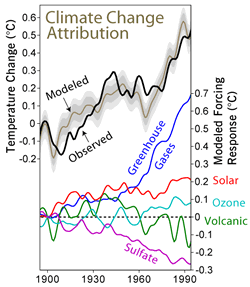Topics
GeographyHeadlinesInfrastructureKatrinaNeighborhoodsPeopleRecreation
|

Much current climate research is centered on computer modeling. The
goal is to produce a comprehensive computerized mathematical model of
the Earth's climate that can predict the future climate. A way to test
whether a model can predict the future is to see if it can accurately
simulate the past. Many models are seeded with data representative of
1900 then run through 2000 and the results compared to observed values.
If the match is good the model is setup with accurate current data and
assumptions for key parameters entered and the model is run through
some future date like 2100.
The most complex climate models, termed coupled atmosphere-ocean general circulation
models (and abbreviated as AOGCM), involve coupling comprehensive
three-dimensional atmospheric general circulation models (AGCMs), with ocean
general circulation models (OGCMs), with sea-ice models, and with models of
land-surface processes, all of which are extensively reviewed in the SAR (Chapters
4 and 5). For AOGCMs, information about the state of the atmosphere and the
ocean adjacent to, or at the sea surface, is used to compute exchanges of heat,
moisture and momentum between the two components.
IPCC 2001 lists 31 AOGCM's. IPCC provides datasets representative
of past and current conditions and outlines scenarios representing
future conditions. These data have been used with the various models to
produce the range of future conditions that the IPCC presents as the
result of various climate policies.
Why is it so hard to model the climate?
We have only recently been able to get agreement on how to accurately record temperature levels at various testing stations. How do you combine that data to get a world wide average? What about day night cycles and the seasons. Is the winter average different than the summer. It is valuable to have temperature readings at different altitudes and these are even harder to get. Cities have been growing and they change the climate. Concrete is hotter than trees so just the presence of a growing city near a recording station can make the temperature appear to be changing. Recently we've been using satellites and the data is better.
Then there is the ocean. Are sea levels rising? Did you realize that water expands as it grows hotter. Its a tiny percentage, but it is enough to make the sea level change even without adding any more water. Floating icebergs don't change the water level at all as they melt. Since there is no land in the Arctic, all the ice in that ice cap is floating. Only Greenland and Antarctica have significant amounts of ice on land that could add to the amount of water in the oceans.
And ocean currents have only recently been studied. Effects like El Nino have been observed for centuries but only recently tied to larger ocean currents. We know they affect climate and a lot of observational work has been done. Basic research is just beginning to develop explanations for these currents and the underlying mechanisms. Atmospheric currents like the jet stream need to be understood as well.
|